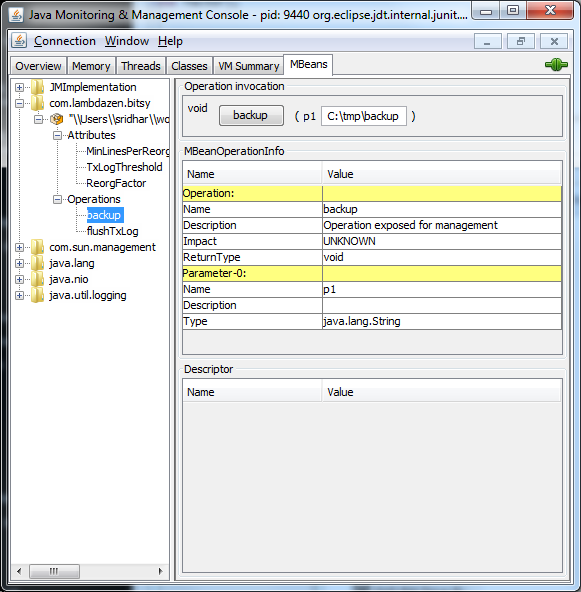Wiki
Clone wikibitsy / MonitoringAndManagement
Monitoring and Management
JMX interface
Bitsy exposes the following monitoring and management methods over JMX:
- Get and set key tuning parameters: These parameters are exposed as JMX attributes.
- Online backup: The backup() operation takes a String parameter that refers to the directory to which the database should be backed up. Refer to the page Backup and Restore for information on restoring the database and making offline backups
These can be accessed using jconsole under com.lambdazen.bitsy. Here is a screenshot of jconsole showing the three tuning parameters and operations to
- Backup the database while it is running, and
- Flush the transaction log (refer to "transaction log flush" in the write algorithms page).

The above screenshot also shows an online backup to folder of "C:\tmp\backup" using JConsole.
Monitoring memory
When using Bitsy in a production system, it is good to periodically monitor the JVM GC activity. If full GCs are very frequent and the memory available after a full GC is low -- you might have a problem. You should be able to automate this process using off-the-shelf JVM monitoring tools.
You can restart the server with a larger -Xmx setting (better to leave some room to expand in production) while implementing an archiving strategy to remove obsolete data from the database.
Acessing Bitsy's logs
Bitsy uses the SLF4J API to log messages. If the embedding application doesn't include an SLF4J implementation (like Logback), no log messages will be output. Otherwise, the log messages will go to the respective implementation.
You can set the log level to ERROR, INFO or DEBUG based on your requirements. The loggers used by Bitsy are named after the respective classnames, and always begin with "com.lambdazen".
Updated